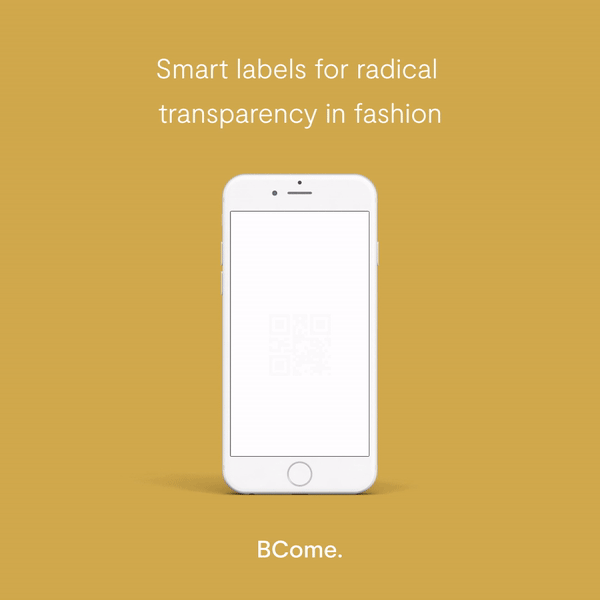In recent years, radical transparency has become an increasingly popular concept in the fashion industry. While commercial messages linked to “more responsible” practices multiply, marketing departments must rely on honesty to conquer an increasingly aware consumer who doesn’t accept empty messages when making purchase decisions. Radical transparency means taking an honest communication approach that lets consumers know the story of the products they are buying to enable them to make more informed decisions. Discover how smart labels can become your allies when it comes to building a relationship of trust with your consumer.
At BCOME we not only rely on data as a tool to identify areas for brand improvement, but also as the most honest method of engaging with the consumer
Garment labels are an essential part of the fashion industry. The codes used in the labeling system were first introduced almost 60 years ago and since then the content of textile labels has hardly changed. However, thanks to technology and innovation, more and more brave brands are daring to include valuable information on their product labels. At BCOME we not only rely on data as a tool to identify areas for brand improvement, but also as the most honest method of engaging with the consumer.
Performance indicators are the best demonstration of a company’s sustainable commitment. Our brands integrate the traceability of their products into their e-commerce and label their garments with smart labels that collect all the information through a QR. There are already more than 50 brave brands that trust BCOME to give the user the freedom to navigate through their data to ease conscious decision-making.

When we talk about transparency in the fashion industry, we must take into account the following fundamentals to exercise it accurately:
- Transparency policies must be extended to the entire supply chain. Traceability and transparency are two closely related concepts.
- Betting on radical transparency implies admitting mistakes and showing both the successes of the brand and those aspects in which it needs to progress. It is important to put transparency before perfection.
- Transparency should be understood as an educational tool to spread understandable messages to the audience.
Companies must have evidence to support the data they report
With the increasing popularity of greenwashing in fashion, smart labels have become an essential tool to fight misinformation in the textile sector. Having data that works as support for the sustainability claims made by brands will be vital to demonstrate the basis of those claims. Companies must have evidence to support the data they report. Working with a partner like BCOME that validates the information released by the company will generate trust and credibility on the part of the end customer.
Below we show you the indicators that consumers can access by reading our smart labels on physical products or in the brand’s e-comm thanks to BCOME technology:
Traceability data. The journey of the item from km 0 to the point of sale.
- People. Average number of people involved throughout the entire product value chain.
- Suppliers. Average number of suppliers involved throughout the entire product value chain.
- Processes. Average number of processes that are carried out to produce the product.
- KM. Total route traveled for the production of the garment from the extraction stage of the raw material to the manufacturing stage.
Environmental assessment data. The environmental impacts of products throughout their life cycle.
- Water use (m3). Potential of water deprivation, to either humans or ecosystems, due to the water consumption in the product value chain.
- Global warming (kg CO2 eq). Heat absorbed by any greenhouse gas released in the atmosphere from the product value chain.
- Eutrophication (g PO43- eq). Accumulation of phosphates and nitrates released by the use of pesticides, fertilizers, detergents and other chemicals in an ecosystem.
- Resources use – fossils (MJ). Depletion of nonliving (abiotic) resources including oil, natural gas and coal used as energy sources.
Equivalences of environmental impacts. More understandable units for interpreting impacts.
- Water use. Number of 1.5 liter water bottles or Olympic pools with a standard volume of 2,500,000 liters.
- Global warming. Hours of charging a phone or number of 40W LED bulbs on for 24 hours.
- Eutrophication. Kg of tomatoes produced in a greenhouse without heating or volume of 3-liter bottles of laundry detergent.
- Resources use – fossils. Hours of use of a 1.6 kW hair dryer or fossil fuel consumption for refueling 50 l of cars with low-sulfur diesel
Sustainability index. Sustainability performance in a single index.
- Planet. It collects all the practices for environmental efficiency and the responsible use of resources.
- People. Indicates all practices created to ensure work, social and animal conditions are safe and ethical.
- Transparency. It compiles all practices for promoting actions oriented towards circular production and consumption where resource loops are closed and valuable materials recovered.
- Circularity. It represents all practices for promoting actions oriented towards circular production and consumption where resource loops are closed and valuable materials recovered.
At BCOME we believe that transparency is the beginning to build a relationship of authenticity and trust with customers. The starting point to achieve a sustainable, responsible and fair fashion industry. We have the tools you need to start the sustainable transformation of your brand and we want to help you achieve it. Let’s create change together!





